|
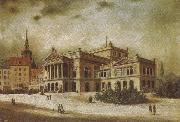 |
arthur o shaughnessy
|
|
1844 C 81, English poet and naturalist. He was a member of the zoological department of the British Museum. He wrote four volumes of poetrye Epic of Women (1870), Lays of France (1872), Music and Moonlight (1874), and Songs of a Worker (1881)??which all reveal the influence of D. G. Rossetti. One ode, beginning, We are the music-makers, is his best-known poem. |
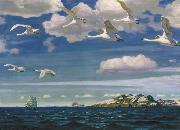 |
Arkady Alexandrovich Rylov
|
|
Arkady Alexandrovich Rylov (Russian, 29 January [O.S. 17 January] 1870 - June 22, 1939) was a Russian and Soviet Symbolist painter.
Biography
Rylov was born in the village Istobenskoye, Vyatka gubernia. He was brought in the family of his stepfather, a notary (Rylov's father had a psychiatric illness). He moved to Saint Petersburg and studied at the Technical Design School of Baron Schtiglitz (1888-1891), then at the Imperial Academy of Arts under Arkhip Kuindzhi (1894-1897).
In the Blue Expanse, 1918Rylov was a member of the Mir iskusstva movement and its spin-off Union of Russian Artists also a member of the Association of Artists of the Revolutionary Russia. He was a chairman of the Kuindzhi Society. |
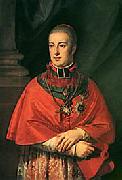 |
Archduke Rudolf of Austria
|
|
Rudolf Johannes Joseph Rainier von Habsburg-Lothringen, Archduke and Prince Imperial of Austria, Prince Royal of Hungary and Bohemia (8 January 1788 - 24 July 1831) was a Cardinal, an Archbishop of Olomouc, and a member of the House of Habsburg-Lorraine.
Born in Pisa, Italy, he was the youngest son of Emperor Leopold II and Maria Louisa of Spain. He was elected archbishop of Olomouc in 1819 and became cardinal in the year 1820.
In 1803 or 1804, Rudolf began taking lessons in piano and composition from Ludwig van Beethoven. The two became friends, and Rudolph became a supporter and patron of Beethoven; their meetings continued until 1824. Beethoven dedicated 14 compositions to Rudolph, including the Archduke Trio, the Hammerklavier Sonata, the Emperor Concerto and the Missa Solemnis. Rudolph, in turn, dedicated one of his own compositions to Beethoven. The letters Beethoven wrote to Rudolph are today kept at the Gesellschaft der Musikfreunde in Vienna.
On 24 March 1819 he was appointed, at the age of 31, Archbishop of Olomouc in the present day Czech Republic but then part of the Austrian Empire. He was made Cardinal-Priest of the titular church of S. Pietro in Montorio by Pope Pius VII on 4 June 1819. He was ordained a priest on 29 August 1819, and consecrated a bishop on 26 September.
In 1823 - 24, he was one of the 50 composers who composed a variation on a waltz by Anton Diabelli for Vaterländischer Kenstlerverein. In Rudolf's case, the music was published anonymously, as by "S.R.D" (standing for Serenissimus Rudolfus Dux).
|
 |
Alfred Ordway
|
|
(1821 - 1897) was an American landscape and portrait painter, and one of the founding fathers of the Boston Art Club.
Alfred was born in Roxbury, Massachusetts to mother Currier, and father Thomas Ordway on March 9, 1821. With his father being the cities' clerk, Alfred spent the majority of his childhood in Lowell, Massachusetts. His family can be traced back to the early 17th century when James Ordway settled in Dover, New Hampshire. Both his parents fought in the Revolutionary War, and his grandfather, Nehemiah Ordway, a physician in Amesbury, Massachusetts, was put in charge "to form and equip a company for Bunker Hill". |
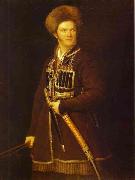 |
Aleksander Orlowski
|
|
(March 9, 1777 - March 13, 1832) was a Polish painter and sketch maker, pioneer of lithography in the Russian Empire.
Orłowski was born in 1777 in Warsaw to a tavern-keeper. In his early childhood he became known as a prodigy and soon Izabela Czartoryska financed his first classes of painting with the notable artist Jan Piotr Norblin. In 1793 Orłowski joined the Polish Army and fought in the Kościuszko Uprising against Imperial Russia and Prussia, but was wounded and returned to Warsaw for further studies, financed by Prince Jezef Poniatowski. He studied with many notable painters of the epoch, among them Norblin, Marcello Bacciarelli and Wincenty Lesserowicz. In 1802, after the Partitions of Poland, he moved to Russia, where he became one of the pioneers of lithography.
Among his works are countless sketches of everyday life in Poland and Russia, as well as scenes of the Kościuszko Uprising and other Polish wars.
|
 |
Aleksander Orlowski
|
|
Aleksander Orłowski
Aleksander Orłowski (March 9, 1777 - March 13, 1832) was a Polish painter and sketch maker, pioneer of lithography in the Russian Empire.
Orłowski was born in 1777 in Warsaw to a tavern-keeper. In his early childhood he became known as a prodigy and soon Izabela Czartoryska financed his first classes of painting with the notable artist Jan Piotr Norblin. In 1793 Orłowski joined the Polish Army and fought in the Kościuszko Uprising against Imperial Russia and Prussia, but was wounded and returned to Warsaw for further studies, financed by Prince Jezef Poniatowski. He studied with many notable painters of the epoch, among them Norblin, Marcello Bacciarelli and Wincenty Lesserowicz. In 1802, after the Partitions of Poland, he moved to Russia, where he became one of the pioneers of lithography.
Among his works are countless sketches of everyday life in Poland and Russia, as well as scenes of the Kościuszko Uprising and other Polish wars.
|
 |
Albert van Ouwater
|
|
Albert van Ouwater (c. 1410/1415-1475) was one of the earliest artists of Early Netherlandish painting working in the Northern Netherlands, as opposed to Flanders in the South of the region.
[edit] BiographyHe was probably born in Oudewater, and is mentioned by Karel van Mander (1604) as a reputable painter at the time in which he lived.[1] According to Karel van Mander he was possibly a contemporary of Jan van Eyck and had been the teacher of Geertgen tot Sint Jans, though he was quick to qualify this statement with the eye-witness account of an old man named Albert Simonsz who had been a pupil of Jan Mostaert and claimed neither he nor Mostaert had ever even heard of this Albert van Ouwater or Geertgen tot Sint Jans.[1] Van Mander highly commends an altarpiece by Van Ouwater in the principal church in Haarlem, the Grotekerk or Sint-Bavokerk, representing St. Peter and St. Paul, in which the figures are carefully and correctly designed, and richly coloured.[1] Van Mander posits Van Ouwater as the founder of the Haarlem school of painting, making him the first major Dutch (as opposed to Flemish) artist. According to Van Mander, landscape painting was a particular specialty of this Dutch school, although none of Van Ouwater's surviving works exhibit this tendency. Van Ouwater seems to have been a contemporary of Dirk Bouts in mid-15th-century Haarlem, and Geertgen tot Sint Jans may have been his pupil. |
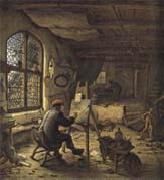 |
Adriaen van ostade
|
|
Dutch Baroque Era Painter, 1610-1685
Painter, draughtsman and etcher. According to Houbraken's rather unreliable biography, he was a pupil concurrently with Adriaen Brouwer of Frans Hals in Haarlem. Hals influenced him very little, whereas Brouwer, who was described as 'known far and wide' as early as 1627, had a decisive influence on the evolution of Adriaen van Ostade's always idiosyncratic portrayal of peasant life. The first documentary mention of Adriaen van Ostade as a painter is in 1632 (Schnackenburg, 1970). Most of his paintings are signed and dated, the earliest firmly dated example being the Peasants Playing Cards |
|

